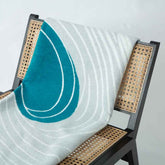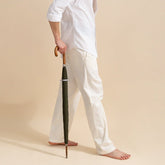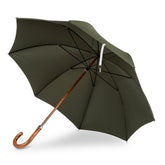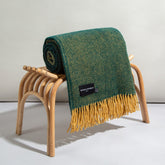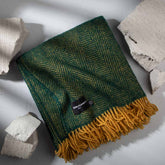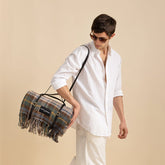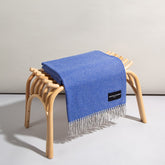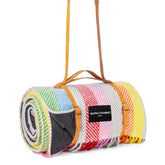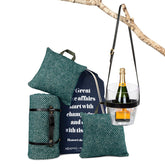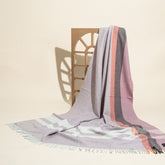Travelling with Cashmere
Revered for its unparalleled softness, warmth, and lightweight nature, cashmere is more than just a symbol of refined taste – it's a traveller's secret weapon. Whether you're wrapping yourself in a plush cashmere blanket during a long flight or accessorising with a chic scarf to elevate your travel ensemble, cashmere brings a touch of home-comfort and elegance wherever your journey takes you.
In this guide, we delve into the art of travelling with cashmere, focusing on two quintessential items: scarves and blankets. We understand that your cashmere pieces are not just accessories; they are investments in quality and comfort. That's why we're here to offer expert advice on everything from packing without a wrinkle to ensuring your cashmere survives the rigours of travel unscathed.

Why Choose Cashmere for Travel?
When it comes to selecting travel companions, few materials can compete with the allure and practicality of cashmere. Here's why cashmere, particularly in the form of scarves and blankets, should be a staple in your travel arsenal:
Unmatched Comfort and Warmth
- Luxurious Softness: Cashmere is known for its sumptuous softness, providing a gentle, soothing touch against the skin, which is especially appreciated during long, tiresome journeys.
- Insulating Properties: Despite its lightweight nature, cashmere offers excellent insulation. It keeps you warm in cold environments, like chilly aeroplane cabins, without the bulkiness of heavier materials.
Lightweight and Space-Efficient
- Easy to Pack: Cashmere items, due to their fine fibres, can be folded or rolled into compact sizes, making them ideal for saving space in luggage.
- Versatile Use: A single cashmere scarf or blanket can serve multiple purposes, reducing the need for additional items. A scarf, for example, can double as a wrap or shawl, while a blanket can be used as a cosy layer or an impromptu picnic spread.
Durable and Long-Lasting
- Resilience: When cared for properly, cashmere is remarkably durable, resisting pilling and maintaining its shape and texture over time, making it a wise investment for frequent travellers.
- Adaptable to Climates: Cashmere's natural fibres adjust to different temperatures, making it comfortable to use in both cool and moderately warm conditions.
Timelessly Stylish
- Elegance in Simplicity: Cashmere exudes an understated elegance that can elevate any travel outfit, whether you're aiming for a casual look or something more formal.
- Wide Range of Styles: With an array of colours and patterns available, cashmere scarves and blankets can complement various personal styles and preferences.
Hypoallergenic Qualities
Gentle on Skin: For travellers with sensitive skin, cashmere is a hypoallergenic option, reducing the risk of irritation compared to other woollen materials.
Choosing cashmere for travel means investing in comfort, style, and practicality. Its unique blend of luxury and functionality makes it an ideal choice for any journey, providing warmth, comfort, and a touch of elegance. In the following sections, we will guide you through the best practices for packing, caring for, and making the most of your cashmere travel items.

Preparing Your Cashmere for the Journey
Ensuring your cashmere scarves and blankets are well-prepared for travel is key to maintaining their quality and appearance. Here’s how you can pack and protect these delicate items effectively:
Packing Cashmere Scarves
- Folding Techniques: To minimise wrinkles, lay your scarf flat, fold it in half lengthwise, and then gently roll it up. This method also helps in saving space in your suitcase.
- Protection from Snags and Spills: Place your rolled scarf in a soft cotton bag or a zip-lock bag to protect it from snagging on other items in your luggage. This also shields it from accidental spills or stains.
- Avoiding Creases: If you have space, laying the scarf flat on top of other clothes is another way to prevent creases.
Preparing Cashmere Blankets for Travel
- Compact Folding or Rolling: Similar to scarves, fold your blanket in half a few times, then roll it to create a compact bundle. This makes it easy to fit into your suitcase or carry-on.
- Using Protective Coverings: Consider a breathable cotton bag or a pillowcase to store your cashmere blanket. This not only keeps it clean but also prevents it from catching on zippers and other items.
- Positioning in Luggage: Place your blanket at the centre of your suitcase, cushioned by clothes. This provides extra padding and reduces the chance of it getting compressed or damaged.
General Tips
- Balancing Weight: Distribute the weight evenly in your luggage to avoid putting too much pressure on your cashmere items.
- No Overpacking: Ensure your suitcase isn’t too full. Overpacking can lead to your cashmere being squashed or wrinkled.
- Avoiding Sharp Objects: Keep items like shoes, belts with buckles, or toiletries with sharp edges away from your cashmere to prevent accidental snags or tears.
Caring for Cashmere On the Go
Maintaining the elegance and integrity of your cashmere while travelling requires attentive care, especially given the varied environments and situations you may encounter. Here’s how you can ensure your cashmere stays pristine throughout your journey.
Spot Cleaning
When it comes to spills or stains, immediate action is crucial. Gently blot any spillages with a clean, damp cloth, taking care not to rub the fabric, as this can damage the delicate cashmere fibres. For more persistent spots, carrying dry cleaning wipes is a wise choice. These wipes are formulated to lift stains gently without the need for soaking, making them ideal for on-the-spot cleaning.
Avoiding Hazards
Your cashmere is at risk from moths and insects, especially in hotel rooms or other accommodation types. Keeping your items in a sealed bag can provide effective protection. Additionally, be wary of rough surfaces, velcro, and sharp jewellery that might come into contact with your cashmere, as they can easily snag and damage the fibres.
During Use
Care is key when wearing your cashmere scarf or using your blanket. Be cautious of makeup, perfumes, or oils that might stain or affect the fabric. If using a cashmere blanket, choose clean and smooth surfaces to lay it on, particularly if you're using it as a picnic blanket or an extra layer for warmth.
Humidity and Dryness
Cashmere reacts to different climates, so it's important to adapt your care routine accordingly. In humid conditions, airing out your cashmere items regularly is essential to prevent them from absorbing too much moisture. Conversely, in dry environments, static can be a nuisance. A light misting of water or fabric conditioner can help in reducing static cling.
General Care
Regularly airing out your cashmere items is a good practice to keep them fresh, especially if you've been using them extensively during your travels. Also, alternate the way you fold or roll your scarves and blankets to avoid creating persistent creases that can be hard to smooth out later.
By adhering to these care tips, you can keep your cashmere in excellent condition, ensuring it remains a luxurious and comforting companion on your travels.
Using Cashmere Scarves and Blankets During Your Travels
Cashmere, with its blend of elegance and comfort, can be your most versatile travel companion. Let's explore how you can make the most of your cashmere scarves and blankets during your journey.
Versatility of Cashmere Scarves
The beauty of a cashmere scarf lies not only in its luxurious feel but also in its adaptability. It can be a fashion statement, a practical accessory, or a makeshift comfort tool. Drape it elegantly over your shoulders for a chic look, or wrap it around your neck for added warmth during a chilly flight. In more informal settings, it can be styled as a headscarf or even used as a light shawl during cool evenings. The scarf's compact size also makes it ideal for use as a soft pillow or an eye cover when you need to catch some rest during travel.

Comfort with Cashmere Blankets
A cashmere blanket is the epitome of travel luxury. It’s perfect for adding an extra layer of warmth on a plane or during a road trip. Its lightweight nature makes it easy to carry around, ready to be unfurled whenever you need a cosy wrap. In your accommodation, it can serve as a comforting reminder of home, whether draped over a chair for added warmth or used as a blanket for a restful night's sleep. For outdoor enthusiasts, it can transform into a luxurious picnic blanket, offering a touch of elegance to your outdoor adventures.
Storing Cashmere During Your Stay
Proper storage of your cashmere items while you're away from home is crucial for maintaining their quality and longevity. Here are some tips on how to store your cashmere scarves and blankets during your travels:
When you arrive at your destination, the first step is to unpack your cashmere items. It's important to remove them from any tight packing to allow the fibres to breathe and regain their natural shape. If possible, hang your cashmere scarf on a hanger or lay it flat on a clean surface. Avoid hanging it in direct sunlight or in damp areas, as this can cause the fabric to fade or develop a musty smell.
For cashmere blankets, if you're not using them daily, fold them gently and place them in a dry, airy spot. If your accommodation has drawers or shelves, these can be ideal places to store your blanket. However, make sure the area is clean and free from potential pests like moths or beetles that could damage the cashmere.
Humidity can be a concern, especially in certain climates or during specific seasons. If the room you're staying in is particularly humid, consider storing your cashmere items in a breathable cotton bag. This will protect them from moisture while still allowing air circulation.
Conversely, in very dry environments, static can be an issue. To combat this, you can lightly mist your cashmere with water using a spray bottle, or use a humidifier in the room to maintain a balanced level of humidity.
Additionally, if you're staying in a location for an extended period, it's a good idea to periodically refold or reroll your cashmere items to prevent creases from setting in. This is particularly important for cashmere blankets, which can develop stubborn fold lines if left in the same position for too long.


























